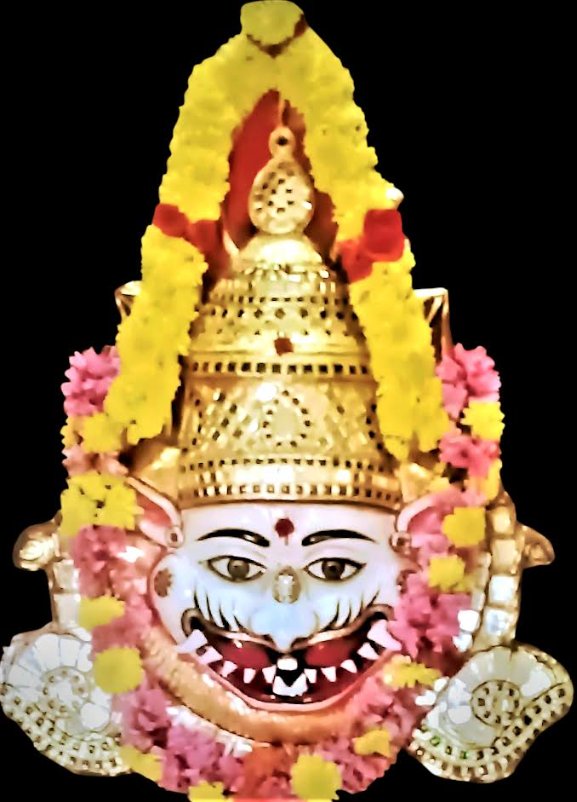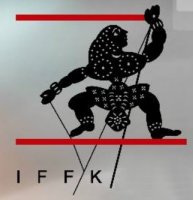Snippets of Information
Theatre / Puppetry
* 5 Mar 2023

The Mask of Narasimha at Melattur is said to be around three
centuries old. It has been carved out of a single bark of a fig tree and
embedded with semi-precious red and green stones, cut glasses set with
Tanjore Art & Painting work. Until this day, the mask has been
refurbished with rituals four times.
In order to enhance and safeguard the ritualistic significance of this
Treasure, ‘Appilai’ Narayanaswami Iyer, Melattur during his last days
handed over the Mask in 1940/41 to V.Ganesa Iyer, the founder of SLNJ
Bhagavata Mela Natya Nataka Sangam who revived this Art Form at Melattur
after it fell in to oblivion in 1932. V.Ganesa Iyer installed the Holy
Mask at the Sannidhi of the Varadaraja Perumal Temple, Melattur.
Ever since, it has been in worship and continues to be an integral part
of the 'Prahlada Charitamu' - the Bhagavata Mela Natakam at Melattur.
During the occasion, the Mask is brought out of the temple to the dias
only once a year with religious fervour amidst Vedic Chants to be
adorned for The Narasimha Avataram.
The person who dons the Mask gets into a trance and at the end of the
play, Lord Narasimha along with the characters of Bhoomi Devi and
Prahladan are taken around the streets of the Temple as the Bhagavathas
sing the Hari Bhajans. During this procession, the villagers offer
Arathi and when the dancer donning Narasimha returns to normal from
trance, the Mask is taken out, covered and returned immediately to the
Temple ensuring its sanctity.
Source: melattur-bhagavatamela.org
* 13 Nov 2022
The Vira-Saivite poet Palkuriki Somanatha mentions in his well-known work ‘Panditaradhya Charitra’
about such dramatic performances at the Srisailam Hill on the occasion
of ‘Mahashivratri’. It is thus evident that the folk theatre tradition
in Andhra can be traced back to the period of Kalyani Chalukyas, if not
earlier. Palkuriki Somnatha composed one of the very early forms of
indigenous musical drama known as ‘Bahu Naraka’ around 1250 A.D. which
portrayed the ten varieties of the ‘Shivalila’ episodes. With time,
these took the form of the ‘Yakshagana’ plays, common to many regions of India. The other major forms of the Telugu folk theatre are ‘Burra Katha’, ‘Veethi Bhagavatamu’ and the leather puppet show, ‘Tolubommalatalu’.
Source: culturopedia.com
* 13 Nov 2022
Pagati Veshalu also called by the name Bahurupalu i.e. 'many
roles is a popular and historic folk theater form in Andhra Pradesh. It
is performed by three to four individuals who focus on contemporary
society and some of its mannerisms. Pagati Veshalu aims to bring reforms
in the society through satire. It is enacted only during the day time
and is hence called Pagati Veshalu. The dance is known for portraying
characters of less privileged communities in a positive way and it is
considered synonymous with theatre in Telugu literature. According to
legend and tradition, kings used to encourage their spies to disguise
themselves as individuals from every walk of life, and mingle with the
common man, to understand how people felt about their rule. This is also
termed Pagati Veshalu.
Source: shilparamamap.net
Pagati Veshaalu is role-playing by donning a costume and assuming
another’s role. It is popular in the Telangana region and in the Krishna
district of Andhra Pradesh. Each performance revolves around a single
episode consisting of a prominent “vesham” (disguise) and other less
important characters. Pagati Veshaalu is performed consequently for four
to five days and each day’s performance centres around one character.
Source: culturopedia.com
* 3 Jan 2022
Pavakathakali or Puppet Kathakali

The Aandipandaras were puppeteers from Paruthippulli and Kodumbu
villages in Palakkad, Kerala. The means for their main source of income
was to offer puja in households for Lord Subramanya and guide pilgrims
on their way to Palani. Apart from this, some of them were good in
various types of performances. It was a small group from among these who
worked as puppeteers. It is believed that they came from Andhra Pradesh
via Tamil Nadu and settled in Kerala. When they reached Kerala, they
used to perform the Aryamaala, the Tamil folk drama as puppet show.
Later when Kathakali became popular in Kerala, they carved Kathakali
figures, studied the text and shaped it to make it their own art form.
Chamu Pandaram was a noted artist in the twentieth century.
Kamaladevi Chattopadhyay who happened to see two such puppets in the
museum in Thrissur first underlined the need to revive this art form.
She was instrumental in providing the impetus and support to revive most
of the puppet forms in India. Later, she entrusted Venu G to continue
with research in this area. When the main performers Chamu
Pandaram and his colleague Velayudhan Pandaram had passed away, only KV
Ramakrishnan, the son of Velayudhan Pandaram, KC Karuppan, KC
Ramakrishnan, the children of Chamu Pandaram, percussionist V Thankappan
remained in the traditional family who could just about handle the art
form. But none of them had the expertise to make puppets. Thottassery
Narayanan, Kathakali artist and costume designer took it on himself to
make the puppets studying the old puppets. At present, there is a
small troupe at Natanakairali to preserve this art form.
Source: Pavakathakali by Kapila Venu, narthaki.com, December 4, 2011
* 28 Aug 2021
Tholpavakoothu (shadow leather puppetry) is a centuries-old art form from
Kerala acting out a story with leather puppets is preserved as a family
tradition by the Pulavars.

It is an ancient peculiar ritualistic art form dedicated to Bhagavati, worshiped by the people of Kerala as the Mother Goddess.
As a ritualistic art form, Tolpava Koothu is performed during the months
of January to May at the especially constructed theatre called Koothu
Madam in front of the Bhagavati temple.
- It is said to have originated in the 18th century is also known as pavakoothu (puppet play) or nizhalattam (shadow play).
- The puppets are fashioned out of the hides of buffaloes and deer, the former for evil characters and latter for noble ones.
- The puppet plays are based on selected verses from the famous Tamil
Epic 'Kamba Ramayana'. The language used is a dialect of Tamil with an
admixture of Sanskrit and Malayalam words.
- Ezhupara, a cylindrical drum made out of jack-fruit wood and covered
with calf-skin on both ends and Ilathalam (cymbals) are the main
accompaniments. Shankha (conch), Chenda and Maddalam (drums), Chengila
(gong) and Kurum-kuzhal (a short pipe) are further instruments to be
used on special occasions.
Source: tholpavakoothu.in

The logo of the International Film Festival of Kerala is that of a tholpavakoothu puppet.
"Tholpavakoothu in temples focusses on the rendering of The Ramayana
from Kamba Ramayanam. The tholpavakoothu performance at temples lasts
for 10 hours. It goes on for 21 days at the Devi temple in our village
in Koonathara, Shornur (Thrissur district)", says KK Ramachandra
Pulavar, recipient of the Padma Shri, who learnt the art from his father
late Krishnakutty Pulavar.
Source: KK Ramachandra Pulavar expands the scope of
'tholpavakoothu' by Saraswathy Nagarajan, The Hindu, Thiruvananthapuram,
Feb 22, 2021
* 21 Aug 2021
Kuchipudi Bhagavathamelam - dance theatre
The lives of Kuchipudi Bhagavathamelam essentially follow the Hindu
Sanatana Dharma, a way of living through which one may achieve moksha
(enlightenment, liberation) in right earnest. For the Bhagavathamelam,
dance is a divine approach to fulfill their samskaras and probably that
is the reason they are totally 'manasa', 'vacha' and 'karmane'
wholeheartedly into dance all through their lives with body, mind and
soul. The Kuchipudi Bhagavathamelam's life could be broad based into
five areas like the five elements of life, namely learn, perform, teach,
propagate and keep the traditions alive.
The deeds of Siddhendra Yogi is all too familiar to repeat but it would
augur well to know that until this day the Kuchipudi Bhagavathamelam
uphold their promise to him, that at least one son of the traditional
families of Kuchipudi village will pursue dance. As requested by him, at
least once in their life time they will don the female personification
role in 'his' famous creation, 'Bhama Kalapam' which he taught to the
Kuchipudi traditional families.
The traditional families of Kuchipudi art who form the Kuchipudi
Bhagavathamelam comprises namely the Bhagavatula, Bokka, Challa, Chinta,
Chitalapati, Darba, Hari, Josyula, Mahankali, Pasumarti, Pillala Marri,
Somayajulu, Taddepalli, Vedantam, Vempati and Yelleswarupu. They have
been and continue to be the torch bearers of the art form ensuring the
nativity of the dance traditions of Kuchipudi comprising of Samskrutha
roopakams, Kalapams, Yakshaganams, Kelikas; solos are not compromised
and the same is preserved for posterity.
Source: Kuchipudi Bhagavathamelam: A rich cultural heritage by Tadepalli Satyanarayana, narthaki.com
* 21 Aug 2021
Kalasutri Bahuliya - puppetry art of Maharashtra
Kalasutri Bahuliya has its origin in 1600 A.D. Also known as Zaiti, it
is a Marathi folk form, immensely popular till the twentieth century -
'Kal' meaning forefingers of human hand, 'Sutri' meaning black thread
and 'Bahuliya' meaning puppets. This is a small wooden puppet with
moveable arms and shoulder joints.
Kalasutri string puppets came from the Rajasthan-Gujarat area to
Maharashtra and were given patronage by the rulers of Sawantwadi. The
town of Sindhudurg known as the puppetry village has been home for
praramparik kalakars or traditional folk artists from mid-eighteenth
century onwards.
The puppets are carved from the lightwood of pangara that is the coral
tree. The themes presented in a Kalasutri Bahuliya theatre are usually
based on two epics, Ramayana and Mahabharata. The scenes from Krishna
Puran are also performed, most common being the Dashavataram and
Bhagawad Gita Upadesham. It is always performed with live folk music.
Source: Kalasutri Bahuliya: A dying puppetry art of Maharashtra by Charanya Gurusathya, narthaki.com
|